克鲁德曼国际经济学PPT第18章
- 格式:pdf
- 大小:3.00 MB
- 文档页数:45
![国际经济学克鲁格曼版[]PPT课件](https://uimg.taocdn.com/90382b676c175f0e7dd1372e.webp)


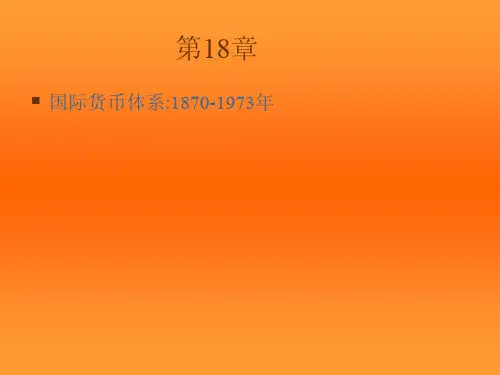
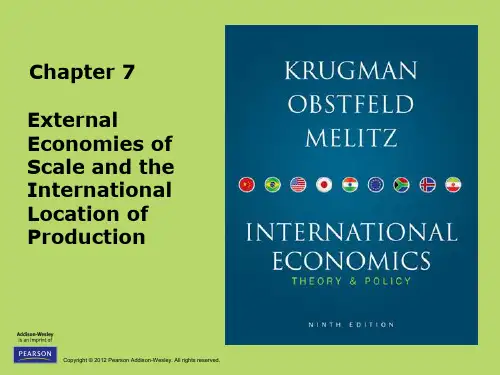
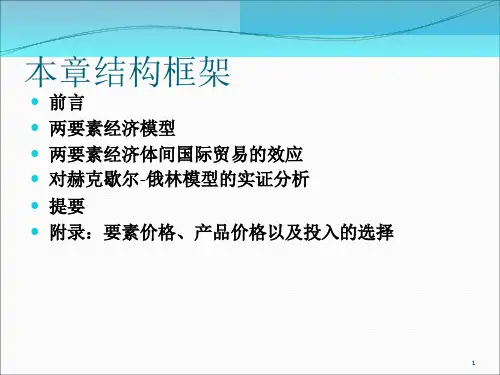
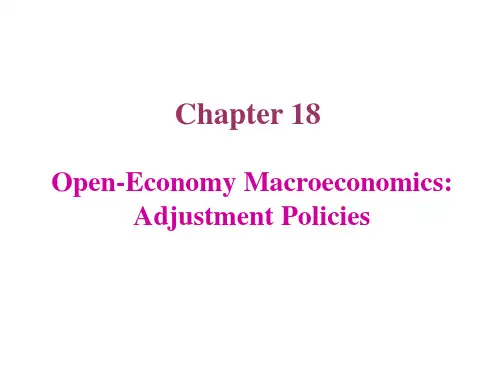
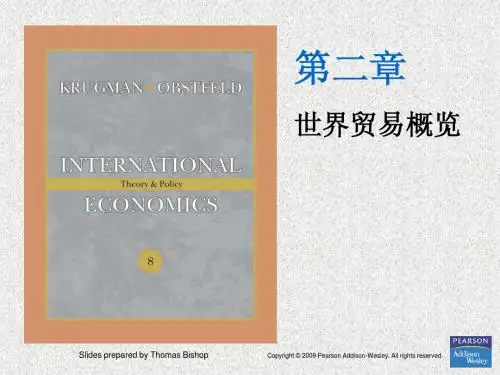
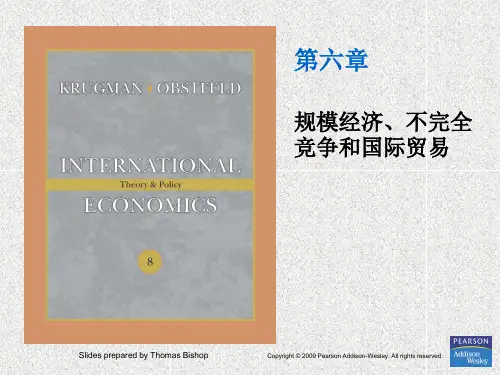
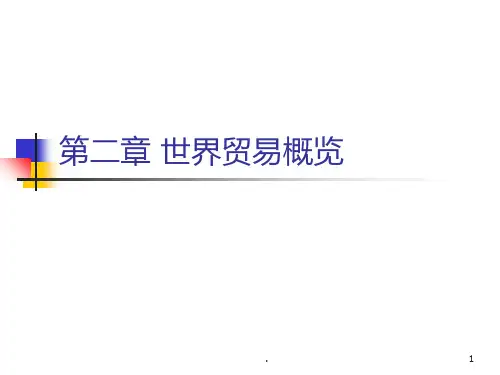

保罗克鲁格曼国际经济学英⽂课件1-7章Preface§1. Some distinctive features of International Economics: Theory and Policy.This book emphasizes several of the newer topics that previous authors failed to treat in a systematic way:·Asset market approach to exchange rate determination.·Increasing returns and market structure.·Politics and theory of trade policy.·International macroeconomic policy coordination·The word capital market and developing countries.·International factor movements.§2. Learning features:·Case studies·Special boxes·Captioned diagrams·Summary and key terms·Problems·Further reading§3.Reference books:·[美]保罗?克鲁格曼,茅瑞斯?奥伯斯法尔德,《国际经济学》,第6版,中译本,中国⼈民⼤学出版社,2007.·李坤望主编,《国际经济学》,第⼆版,⾼等教育出版社,2005.·Dominick Salvatore, International Economics, Prentice Hall International,第9版,清华⼤学出版社,英⽂版,2008. Chapter 1Introduction·Nations are more closely linked through trade in goods and services, through flows of money, and through investment than ever before.§1. What is international economics about?Seven themes recur throughout the study of international economics:·The gains from trade(National welfare and income distribution)·The pattern of trade·Protectionism·The balance of payments·Exchange rate determination·International capital market§2. International economics: trade and money·Part I (chapters 2 through 7) :international trade theory·Part II (chapters 8 through 11) : international trade policy ·Part III (chapters 12 through 17) : international monetary theory ·Part IV (chapters 18 through 22) : international monetary policyChapter 2 World Trade: An Overview§1 Who Trades with Whom?1. Size Matters: The Gravity ModelThe size of an economy is directly related to the volume of imports and exports.Larger economies produce more goods and services, so they have more to sell in the export market. Larger economies generate more income from the goods and services sold, so people are able to buy more imports.3 of the top 10 trading partners with the US in 2003 were also the 3 largest European economies: Germany, UK and France. These countries have the largest gross domestic product (GDP) in Europe.Cultural affinity: if two countries have cultural ties, it is likely that they also have strong economic ties.Geography: ocean harbors and a lack of mountain barriers make transportation and tradeeasier.2. Distance Matters: The Gravity ModelDistance between markets influences transportation costs and therefore the cost of imports and exports. Distance may also influence personal contact and communication, which may influence trade.Estimates of the effect of distance from the gravity model predict that a 1% increase in the distance between countries isassociated with a decrease in the volume of trade of 0.7% to 1%.Borders: crossing borders involves formalities that take time and perhaps monetary costs like tariffs. These implicit and explicit costs reduce trade. The existence of borders may also indicate the existence of different languages or different currencies, either of which may impede trade more.3.The gravity modelThe gravity model is:a b c ij i j ijT A Y Y D =?? where a, b, and c are allowed to differ from 1.§2. The Changing Composition of Trade1. Has the World Become “Smaller ”?There were two waves of globalization.1840–1914: economies relied on steam power, railroads, telegraph, telephones. Globalization was interrupted and reversed by wars and depression.1945–present: economies rely on telephones, airplanes, computers, internet, fiber optics,…2. Changing Composition of TradeToday, most of the volume of trade is in manufactured products such as automobiles, computers, clothing and machinery. Services such as shipping, insurance, legal fees and spending by tourists account for 20% of the volume of trade.Mineral products (e.g., petroleum, coal, copper) and agricultural products are a relatively small part of trade.Multinational Corporations and OutsourcingBefore 1945, multinational corporations played a small role world trade.But today about one third of all US exports and 42% of all US imports are sales from one division of a multinational corporation to another.Chapter 3Labor Productivity and Comparative Advantage:The Ricardian Model*Countries engage in international trade for two basic reasons:·Comparative advantage: countries are different in technology (chapter 3) or resource (chapter 4).·Economics of scale (chapter 6).*All motives are at work in the real world but only one motive is present in each trade model.§1. The concept of comparative advantage1. Opportunity cost : The opportunity cost of roses in terms of computers is the number of computers that could have been produced with the resources used to produce a given number of roses.Table 3-1 Hypothetical Changes in Production Million Roses Thousand Computers United States-10 +100 South America+10 -30 Total 0 +702. Comparative advantage : A country has a comparative advantage in producing a good if the opportunity cost of producing that good in terms of other goods is lower in that country than it is in other countries.·Denoted by opportunity cost.·A relative concept : relative labor productivity or relative abundance.3. The pattern of trade: Trade between two countries can benefit both countries if each country exports the goods in which it has a comparative advantage.§2. A one-factor economy1.production possibilities: LC C LW W a Q a Q L +≤Figure 3-1 Home’s Production Possibility Frontier2. Relative price and supply·Labor will move to the sector which pays higher wage.·If C W LC LW P P a a >(C LC W LW P a P a >, wage in the cheese sector is higher ), the economy will specialize in the production of cheese.·In a closed economy, C W LC LW P P a a =.·If each country has absolute advantage in one good respectively, will there exist comparative advantage?§3. Trade in a one-factor world·Model : 2×1×2·Assume: **LC LW LC LW a a a a <Home has a comparative advantage in cheese.Home ’s relative productivity in cheese is higher.Home ’s pretrade relative price of cheese is lower than foreign.·The condition under which home has the comparative advantage involves all four unit labor requirement, not just two.1. Determining the relative price after trade·Relative price is more important than absolute price, when people make decisions on production and consumption.·General equilibrium analysis: RS equals RD . (World general equilibrium)·RS : a “step ” with flat sections linked by a vertical section. **(/)(/)LC LW L a L aFigure 3-3 World Relative Supply and Demand·RD : subsititution effects·Relative price after trade: between the two countries ’ pretrade price.(How will the size of the trading countries affect the relative price after trade? Which country ’s living condition improves more? Is it possible that a country produce both goods?)2. The gains from tradeThe mutual gain can be demonstrated in two alternative ways.·To think of trade as an indirect method of production :(1/)()1/LC C W LW a P P a > or C W LC LW P P a a >·To examine how trade affects each country ’s possibilities of consumption.Figure 3-4 Trade Expands Consumption Possibilities(How will the terms of trade change in the long-term? Are there income distribution effects within countries? )3. A numerical example:·Two crucial points :When two countries specialize in producing the goods in which they have a comparative advantage, both countries gain from trade.Comparative advantage must not be confused with absolute advantage; it is comparative, not absolute, advantage that determines who will and should produce a good.Table 3-2 Unit Labor Requirements Cheese WineHome 1LC a = hour per pound 2LW a = hours per gallonForeign*6LC a = hours per pound *3LW a = hours per gallon absolute advantage; relative price; specialization; the gains from trade.4. Relative wages·It is precisely because the relative wage is between the relative productivities that each country ends up with a cost advantage in one good.***LC LC LW LW a a w w a a >> **LC LC wa w a <;**LW LW wa w a >·Relative wages depend on relative productivity and relative demand on goods.Special box: Do wages reflect productivity?。
Chapter 18•The International Monetary System,1870-197312/4/20142Chapter Organization•Macroeconomic Policy Goals in an Open Economy•International Macroeconomic Policy Under the Gold Standard, 1870-1914•The Interwar Years, 1918-1939•The Bretton Woods System and the International Monetary Fund•Internal and External Balance Under the Bretton Woods System •Analyzing Policy Options Under theChapter Organization•The External Balance Problem of theUnited States•Worldwide Inflation and the Transition toFloating Rates•Summary12/4/20143Introduction•The interdependence of open nationaleconomies has made it more difficult forgovernments to achieve full employmentand price stability.–The channels of interdependence depend onthe monetary and exchange ratearrangements.•This chapter examines the evolution of the international monetary system and how itinfluenced macroeconomic policy.12/4/20144in an Open Economy•In open economies, policymakers aremotivated by two goals:–Internal balance•It requires the full employment of a country’sresources and domestic price level stability.–External balance•It is attained when a country’s current account isneither so deeply in deficit nor so strongly insurplus.12/4/2014512/4/20146•Internal Balance: Full Employment and Price-Level Stability–Under-and overemployment lead to price level movements that reduce the economy ’s efficiency.–To avoid price-level instability, the government must:•Prevent substantial movements in aggregate demand relative to its full-employment level.•Ensure that the domestic money supply does not grow too quickly or too slowly.in an Open Economy12/4/20147in an Open Economy•External Balance: The Optimal Level of the Current Account–External balance has no full employment or stable prices to apply to an economy ’s external transactions.–An economy ’s trade can causemacroeconomic problems depending on several factors:•The economy ’s particular circumstances •Conditions in the outside world•The institutional arrangements governing itseconomic relations with foreign countriesin an Open Economy–Problems with Excessive Current AccountDeficits:•They sometimes represent temporarily highconsumption resulting from misguided governmentpolicies.•They can undermine foreign investors’ confidenceand contribute to a lending crisis.12/4/20148in an Open Economy–Problems with Excessive Current AccountSurpluses:•They imply lower investment in domestic plant andequipment.•They can create potential problems for creditors tocollect their money.•They may be inconvenient for political reasons.12/4/20149in an Open Economy•Several factors might lead policymakers to preferthat domestic saving be devoted to higher levels ofdomestic investment and lower levels of foreigninvestment:–It may be easier to tax–It may reduce domestic unemployment.–It can have beneficial technological spillover effects 12/4/201410Standard, 1870-1914•Origins of the Gold Standard–The gold standard had its origin in the use ofgold coins as a medium of exchange, unit ofaccount, and store of value.–The Resumption Act (1819) marks the firstadoption of a true gold standard.•It simultaneously repealed long-standingrestrictions on the export of gold coins and bullionfrom Britain.–The U.S. Gold Standard Act of 1900institutionalized the dollar-gold link.12/4/201411Standard, 1870-1914•External Balance Under the Gold Standard –Central banks•Their primary responsibility was to preserve theofficial parity between their currency and gold.•They adopted policies that pushed the nonreservecomponent of the financial account surplus (ordeficit) into line with the total current plus capitalaccount deficit (or surplus).–A country is in balance of payments equilibrium whenthe sum of its current, capital, and nonreserve financialaccounts equals zero.–Many governments took a laissez-faireattitude toward the current account.12/4/201412Standard, 1870-1914•The Price-Specie-Flow Mechanism–The most important powerful automaticmechanism that contributes to thesimultaneous achievement of balance ofpayments equilibrium by all countries•The flows of gold accompanying deficits andsurpluses cause price changes that reduce currentaccount imbalances and return all countries toexternal balance.12/4/201413Standard, 1870-1914•The Gold Standard “Rules of the Game”:Myth and Reality–The practices of selling (or buying) domesticassets in the face of a deficit (or surplus).•The efficiency of the automatic adjustmentprocesses inherent in the gold standard increasedby these rules.•In practice, there was little incentive for countrieswith expanding gold reserves to follow these rules.•Countries often reversed the rules and sterilizedgold flows.12/4/201414Standard, 1870-1914•Internal Balance Under the Gold Standard –The gold standard system’s performance inmaintaining internal balance was mixed.•Example: The U.S. unemployment rate averaged6.8% between 1890 and 1913, but it averagedunder 5.7% between 1946 and 1992.12/4/20141512/4/201416The Interwar Years, 1918-1939•With the eruption of WWI in 1914, the gold standard was suspended.–The interwar years were marked by severe economic instability.–The reparation payments led to episodes of hyperinflation in Europe.•The German Hyperinflation–Germany ’s price index rose from a level of 262 in January 1919 to a level of126,160,000,000,000 in December 1923 (a factor of 481.5 billion).The Interwar Years, 1918-1939•The Fleeting Return to Gold–1919•U.S. returned to gold–1922•A group of countries (Britain, France, Italy, andJapan) agreed on a program calling for a generalreturn to the gold standard and cooperation amongcentral banks in attaining external and internalobjectives.12/4/201417The Interwar Years, 1918-1939–1925•Britain returned to the gold standard–1929•The Great Depression was followed by bankfailures throughout the world.–1931•Britain was forced off gold when foreign holders ofpounds lost confidence in Britain’s commitment tomaintain its currency’s value.12/4/20141812/4/201419•International Economic Disintegration –Many countries suffered during the Great Depression.–Major economic harm was done byrestrictions on international trade andpayments.–These beggar-thy-neighbor policies provoked foreign retaliation and led to the disintegration of the world economy.–All countries ’ situations could have beenbettered through international cooperationBretton Woods agreementThe Interwar Years, 1918-1939The Interwar Years, 1918-1939Figure 18-1: Industrial Production and Wholesale Price Index Changes, 1929-193512/4/201420Fund•International Monetary Fund (IMF)–In July 1944, 44 representing countries met inBretton Woods, New Hampshire to set up asystem of fixed exchange rates.–All currencies had fixed exchange rates against the U.S.dollar and an unvarying dollar price of gold ($35 anounce).–It intended to provide lending to countries withcurrent account deficits.–It called for currency convertibility.12/4/20142112/4/201422•Goals and Structure of the IMF –The IMF agreement tried to incorporate sufficient flexibility to allow countries to attain external balance without sacrificing internal objectives or fixed exchange rates.–Two major features of the IMF Articles of Agreement helped promote this flexibility in external adjustment:•IMF lending facilities–IMF conditionality is the name for the surveillance over the policies of member counties who are heavy borrowers of Fund resources.•Adjustable paritiesFundFund•Convertibility–Convertible currency• A currency that may be freely exchanged forforeign currencies.–Example: The U.S. and Canadian dollars becameconvertible in 1945. A Canadian resident who acquiredU.S. dollars could use them to make purchases in theU.S. or could sell them to the Bank of Canada.–The IMF articles called for convertibility oncurrent account transactions only.12/4/201423System•The Changing Meaning of ExternalBalance–The “Dollar shortage” period (first decade ofthe Bretton Woods system)•The main external problem was to acquire enoughdollars to finance necessary purchases from theU.S.–Marshall Plan (1948)•A program of dollar grants from the U.S. toEuropean countries.–It helped limit the severity of dollar shortage.12/4/201424System•Speculative Capital Flows and Crises –Current account deficits and surpluses took onadded significance under the new conditions ofincreased private capital mobility.•Countries with a large current account deficit mightbe suspected of being in “fundamentaldisequilibrium”under the IMF Articles of Agreement.•Countries with large current account surplusesmight be viewed by the market as candidates forrevaluation.12/4/201425System•To describe the problem an individualcountry (other than the U.S.) faced inpursuing internal and external balanceunder the Bretton Woods system of fixedexchange rates, assume that:R = R*12/4/20142612/4/201427•Maintaining Internal Balance –If both P * and E are permanently fixed,internal balance required only full employment.–Investment is assumed constant.–The condition of internal balance: Y f = C (Y f – T ) + I + G + CA (EP */P , Y f – T ) (18-1)–The policy tools that affect aggregate demand andtherefore affect output in the short run.SystemAnalyzing Policy OptionsUnder the Bretton Woods SystemFigure 18-2: Internal Balance (II), External Balance (XX), and the “Four Zones of Economic Discomfort”12/4/20142812/4/201429•Maintaining External Balance–How do policy tools affect the economy ’s external balance?•Assume the government has a target value, X , for the current account surplus.•External balance requires the government to manage fiscal policy and the exchange rate so that:CA (EP */P , Y – T ) = X (18-2)–To maintain its current account at X as it devalues the currency, the government must expand its purchases or lower taxes.SystemSystem•Expenditure-Changing and Expenditure-Switching Policies–Point 1 (in Figure 18-2) shows the policysetting that places the economy in theposition that the policymaker would prefer.–Expenditure-changing policy•The change in fiscal policy that moves theeconomy to Point 1.•It alters the level of the economy’s total demandfor goods and services.12/4/201430Analyzing Policy OptionsUnder the Bretton Woods System–Expenditure-switching policy•The accompanying exchange rate adjustment•It changes the direction of demand, shifting itbetween domestic output and imports.–Both expenditure changing and expenditureswitching are needed to reach internal andexternal balance.12/4/20143112/4/201432Fiscal ease (G ↑ or T ↓)Exchangerate, EXXIIFigure 18-3: Policies to Bring About Internal and External Balance13Devaluationthat resultsin internaland externalbalance 24Fiscal expansionthat results in internaland external balance Analyzing Policy OptionsUnder the Bretton Woods System12/4/201433Problem of the United States •The U.S. was responsible to hold the dollar price of gold at $35 an ounce and guarantee that foreign central banks could convert their dollar holdings into gold at that price.–Foreign central banks were willing to hold on to the dollars they accumulated, since these paid interest and represented an international money par excellence.•The Confidence problem –The foreign holdings of dollars increased untilProblem of the United States•Special Drawing Right (SDR)–An artificial reserve asset–SDRs are used in transactions betweencentral banks but had little impact on thefunctioning of the international monetarysystem.12/4/201434Problem of the United StatesFigure 18-4: U.S. Macroeconomic Data, 1964-197212/4/201435Problem of the United StatesFigure 18-4: Continued12/4/201436Problem of the United StatesFigure 18-4: Continued12/4/201437Problem of the United StatesFigure 18-4: Continued12/4/20143812/4/201439•The acceleration of American inflation in the late 1960’s was a worldwide phenomenon.–It had also speeded up in European economies.•When the reserve currency countryspeeds up its monetary growth, one effect is an automatic increase in monetary growth rates and inflation abroad.•U.S. macroeconomic policies in the late 1960s helped cause the breakdown of thethe Transition to Floating Ratesthe Transition to Floating RatesTable 18-1: Inflation Rates in European Countries, 1966-1972 (percent per year)12/4/20144012/4/201441Figure 18-5: Effect on Internal and External Balance of a Rise in theForeign Price Level, P *Fiscal ease(G ↑ or T ↓)Exchangerate, EXX 1II 11Distance =E ∆P */P *II 2XX 22 the Transition to Floating Ratesthe Transition to Floating RatesTable 18-2: Changes in Germany’s Money Supply and International Reserves, 1968-1972 (percent per year)12/4/20144212/4/201443Summary•In an open economy, policymakers try to maintain internal and external balance.•The gold standard system contains a powerful automatic mechanism for assuring external balance, the price-specie-flow mechanism.•Attempts to return to the prewar gold standard after 1918 were unsuccessful.–As the world economy moved into general depression after 1929, the restored goldstandard fell apart and international economicSummary•The architects of the IMF hoped to designa fixed exchange rate system that wouldencourage growth in international trade. •To reach internal and external balance atthe same time, expenditure-switching aswell as expenditure-changing policieswere needed.•The United States faced a unique external balance problem, the confidence problem.12/4/201444Summary•U.S. macroeconomic policies in the late1960s helped cause the breakdown of the Bretton Woods system by early 1973.12/4/201445。